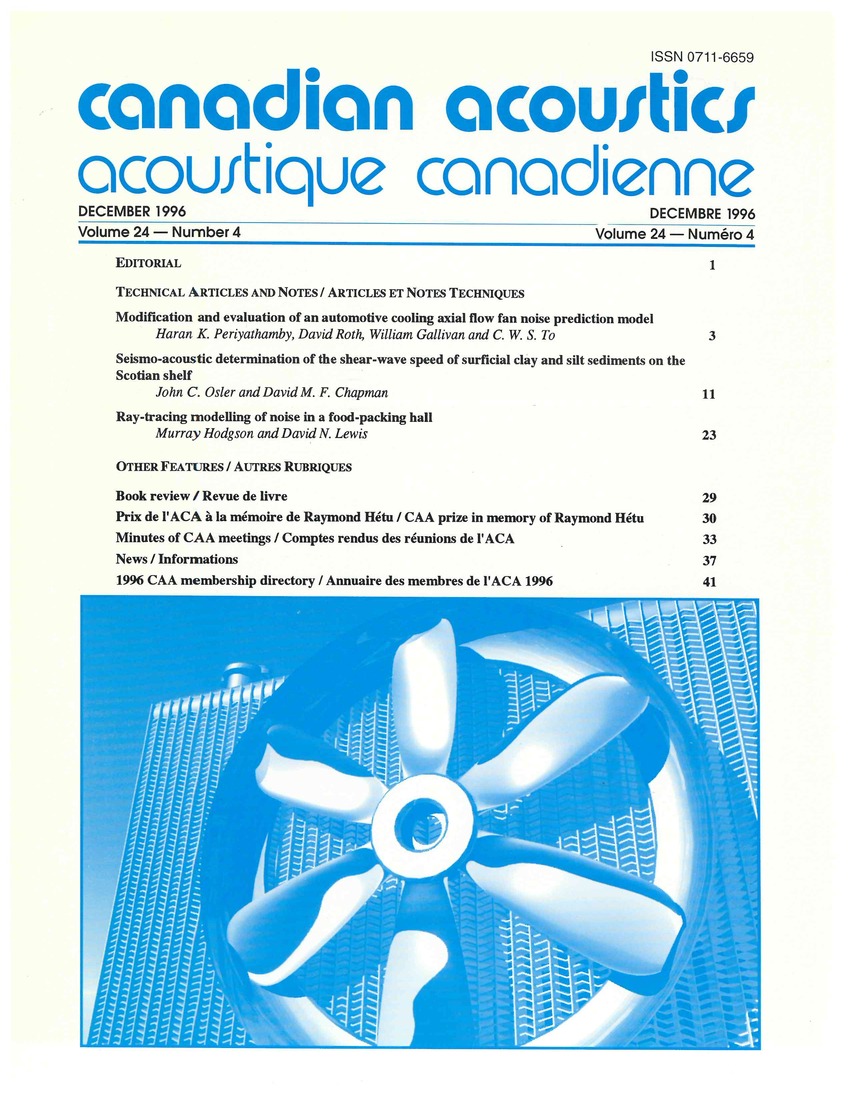Ray-tracing modelling of noise in a food-packing hall
Mots-clés :
Acoustic noise measurement, Cost effectiveness, Noise abatement, Noise ray tracing modelRésumé
En modelisant le champ sonore d'un local de travail, il est possible d'évaluer l'importance de facteurs tels la géométrie du bâtiment, l'absorption de surface, la disposition des machines et la puissance et directivité du son sur les niveaux de bruit aux positions des opérateurs de machines. Ce procédé peut être inestimable au stage de la conception de nouveaux projets, ou pour évaluer l'approche la plus économique pour contrôler le bruit dans un bâtiment déjà construit. L'approche adoptée ici est une prédiction des courbes de propagation du son (bande d'octaves) pour une source de bruit unique dans un environnement de travail particulier, en utilisant le traçage de rayons. Les courbes sont évaluées pour la propagation dans des directions différentes à l'intérieur du bâtiment, et pour des traitements acoustiques différents. Elles sont déterminées approximativement par un ou deux segments droits dont là ou les pentes sont évaluées. Un logiciel séparé est utilisé pour calculer l'effet combiné de toutes les sources de bruit-machine dans le bâtiment à des points de grille séparés de 1 mette, en utilisant les pentes et un facteur de correction environnemental. Ces techniques ont été appliquées avec succès sur un certain nombre de projets importants. Un cas pratique, qui illustre une application au niveau de la conception d’un atelier d'emballage, a été modelisé pour évaluer l'effet d'une augmentation de l'absorption du plafond sur une partie ou sur la surface totale. Le local est décrit, et les prédictions sont présentées en détail. Nous discutons aussi les leçons apprises en rapport au modélisation d'un local.Fichiers supplémentaires
Publié-e
Comment citer
Numéro
Rubrique
Licence
Author Licensing Addendum
This Licensing Addendum ("Addendum") is entered into between the undersigned Author(s) and Canadian Acoustics journal published by the Canadian Acoustical Association (hereinafter referred to as the "Publisher"). The Author(s) and the Publisher agree as follows:
-
Retained Rights: The Author(s) retain(s) the following rights:
- The right to reproduce, distribute, and publicly display the Work on the Author's personal website or the website of the Author's institution.
- The right to use the Work in the Author's teaching activities and presentations.
- The right to include the Work in a compilation for the Author's personal use, not for sale.
-
Grant of License: The Author(s) grant(s) to the Publisher a worldwide exclusive license to publish, reproduce, distribute, and display the Work in Canadian Acoustics and any other formats and media deemed appropriate by the Publisher.
-
Attribution: The Publisher agrees to include proper attribution to the Author(s) in all publications and reproductions of the Work.
-
No Conflict: This Addendum is intended to be in harmony with, and not in conflict with, the terms and conditions of the original agreement entered into between the Author(s) and the Publisher.
-
Copyright Clause: Copyright on articles is held by the Author(s). The corresponding Author has the right to grant on behalf of all Authors and does grant on behalf of all Authors, a worldwide exclusive license to the Publisher and its licensees in perpetuity, in all forms, formats, and media (whether known now or created in the future), including but not limited to the rights to publish, reproduce, distribute, display, store, translate, create adaptations, reprints, include within collections, and create summaries, extracts, and/or abstracts of the Contribution.


